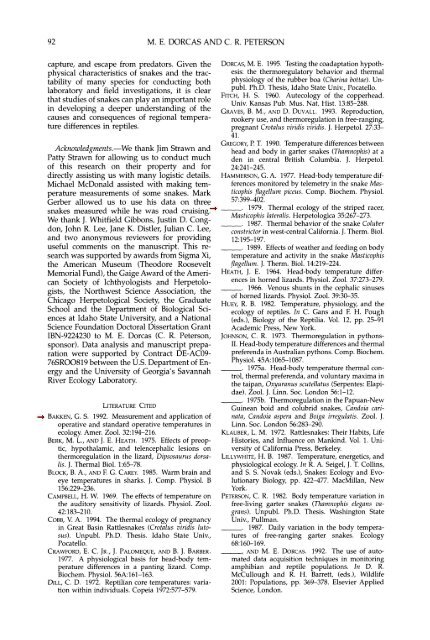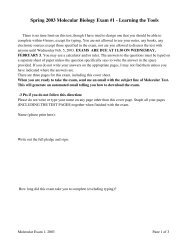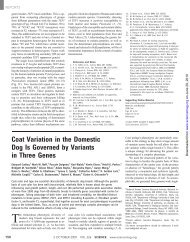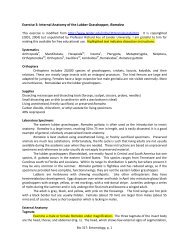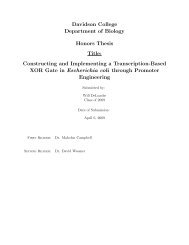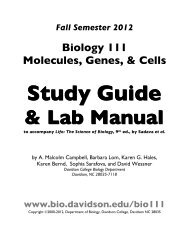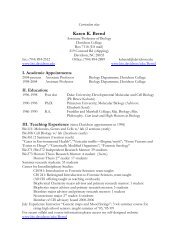Head-Body Temperature Differences in Free-Ranging Rubber Boas
Head-Body Temperature Differences in Free-Ranging Rubber Boas
Head-Body Temperature Differences in Free-Ranging Rubber Boas
Create successful ePaper yourself
Turn your PDF publications into a flip-book with our unique Google optimized e-Paper software.
92<br />
M. E. DORCAS AND C. R. PETERSON<br />
capture, and escape from predators. Given the<br />
physical characteristics of snakes and the tractability<br />
of many species for conduct<strong>in</strong>g both<br />
laboratory and field <strong>in</strong>vestigations, it is clear<br />
that studies of snakes can play an important role<br />
<strong>in</strong> develop<strong>in</strong>g a deeper understand<strong>in</strong>g of the<br />
causes and consequences of regional temperature<br />
differences <strong>in</strong> reptiles.<br />
Acknowledgments.-We thank Jim Strawn and<br />
Patty Strawn for allow<strong>in</strong>g us to conduct much<br />
of this research on their property and for<br />
directly assist<strong>in</strong>g us with many logistic details.<br />
Michael McDonald assisted with mak<strong>in</strong>g temperature<br />
measurements of some snakes. Mark<br />
Gerber allowed us to use his data on three<br />
snakes measured while he was road cruis<strong>in</strong>g.<br />
We thank J. Whitfield Gibbons, Just<strong>in</strong> D. Congdon,<br />
John R. Lee, Jane K. Distler, Julian C. Lee,<br />
and two anonymous reviewers for provid<strong>in</strong>g<br />
useful comments on the manuscript. This research<br />
was supported by awards from Sigma Xi,<br />
the American Museum (Theodore Roosevelt<br />
Memorial Fund), the Gaige Award of the American<br />
Society of Ichthyologists and Herpetologists,<br />
the Northwest Science Association, the<br />
Chicago Herpetological Society, the Graduate<br />
School and the Department of Biological Sciences<br />
at Idaho State University, and a National<br />
Science Foundation Doctoral Dissertation Grant<br />
IBN-9224230 to M. E. Dorcas (C. R. Peterson,<br />
sponsor). Data analysis and manuscript preparation<br />
were supported by Contract DE-AC09-<br />
76SR00819 between the U.S. Department of Energy<br />
and the University of Georgia's Savannah<br />
River Ecology Laboratory.<br />
LITERATURE CITED<br />
BAKKEN, G. S. 1992. Measurement and application of<br />
operative and standard operative temperatures <strong>in</strong><br />
ecology. Amer. Zool. 32:194-216.<br />
BERK, M. L., AND J. E. HEATH. 1975. Effects of preoptic,<br />
hypothalamic, and telencephalic lesions on<br />
thermoregulation <strong>in</strong> the lizard, Dipsosaurus dorsa-<br />
lis. J. Thermal Biol. 1:65-78.<br />
BLOCK, B. A., AND F G. CAREY. 1985. Warm bra<strong>in</strong> and<br />
eye temperatures <strong>in</strong> sharks. J. Comp. Physiol. B<br />
156:229-236.<br />
CAMPBELL, H. W. 1969. The effects of temperature on<br />
the auditory sensitivity of lizards. Physiol. Zool.<br />
42:183-210.<br />
COBB, V. A. 1994. The thermal ecology of pregnancy<br />
<strong>in</strong> Great Bas<strong>in</strong> Rattlesnakes (Crotalus viridis lutosus).<br />
Unpubl. Ph.D. Thesis. Idaho State Univ.,<br />
Pocatello.<br />
CRAWFORD, E. C. JR., J. PALOMEQUE, AND B. J. BARBER.<br />
1977. A physiological basis for head-body temperature<br />
differences <strong>in</strong> a pant<strong>in</strong>g lizard. DORCAS, M. E. 1995. Test<strong>in</strong>g the coadaptation hypothesis:<br />
the thermoregulatory behavior and thermal<br />
physiology of the rubber boa (Char<strong>in</strong>a bottae). Unpubl.<br />
Comp.<br />
Biochem. Physiol. 56A:161-163.<br />
DILL, C. D. 1972. Reptilian core temperatures: variation<br />
with<strong>in</strong> <strong>in</strong>dividuals. Copeia 1972:577-579.<br />
Ph.D. Thesis, Idaho State Univ., Pocatello.<br />
FITCH, H. S. 1960. Autecology of the copperhead.<br />
Univ. Kansas Pub. Mus. Nat. Hist. 13:85-288.<br />
GRAVES, B. M., AND D. DUVALL. 1993. Reproduction,<br />
rookery use, and thermoregulation <strong>in</strong> free-rang<strong>in</strong>g,<br />
pregnant Crotalus viridis viridis. J. Herpetol. 27:33-<br />
41.<br />
GREGORY, P. T. 1990. <strong>Temperature</strong> differences between<br />
head and body <strong>in</strong> garter snakes (Thamnophis) at a<br />
den <strong>in</strong> central British Columbia. J. Herpetol.<br />
24:241-245.<br />
HAMMERSON, G. A. 1977. <strong>Head</strong>-body temperature differences<br />
monitored by telemetry <strong>in</strong> the snake Masticophis<br />
flagellum piceus. Comp. Biochem. Physiol.<br />
57:399-402.<br />
. 1979. Thermal ecology of the striped racer,<br />
Masticophis lateralis. Herpetologica 35:267-273.<br />
. 1987. Thermal behavior of the snake Coluber<br />
constrictor <strong>in</strong> west-central California. J. Therm. Biol.<br />
12:195-197.<br />
. 1989. Effects of weather and feed<strong>in</strong>g on body<br />
temperature and activity <strong>in</strong> the snake Masticophis<br />
flagellum. J. Therm. Biol. 14:219-224.<br />
HEATH, J. E. 1964. <strong>Head</strong>-body temperature differences<br />
<strong>in</strong> horned lizards. Physiol. Zool. 37:273-279.<br />
. 1966. Venous shunts <strong>in</strong> the cephalic s<strong>in</strong>uses<br />
of horned lizards. Physiol. Zool. 39:30-35.<br />
HUEY, R. B. 1982. <strong>Temperature</strong>, physiology, and the<br />
ecology of reptiles. In C. Gans and E H. Pough<br />
(eds.), Biology of the Reptilia. Vol. 12, pp. 25-91<br />
Academic Press, New York.<br />
JOHNSON, C. R. 1973. Thermoregulation <strong>in</strong> pythons-<br />
II. <strong>Head</strong>-body temperature differences and thermal<br />
preferenda <strong>in</strong> Australian pythons. Comp. Biochem.<br />
Physiol. 45A:1065-1087.<br />
. 1975a. <strong>Head</strong>-body temperature thermal control,<br />
thermal preferenda, and voluntary maxima <strong>in</strong><br />
the taipan, Oxyuranus scutellatus (Serpentes: Elapidae).<br />
Zool. J. L<strong>in</strong>n. Soc. London 56:1-12.<br />
1975b. Thermoregulation <strong>in</strong> the Papuan-New<br />
Gu<strong>in</strong>ean boid and colubrid snakes, Candoia car<strong>in</strong>ata,<br />
Candoia aspera and Boiga irregulatis. Zool. J.<br />
L<strong>in</strong>n. Soc. London 56:283-290.<br />
KLAUBER, L. M. 1972. Rattlesnakes: Their Habits, Life<br />
Histories, and Influence on Mank<strong>in</strong>d. Vol. 1. University<br />
of California Press, Berkeley.<br />
LILLYWHITE, H. B. 1987. <strong>Temperature</strong>, energetics, and<br />
physiological ecology. In R. A. Seigel, J. T. Coll<strong>in</strong>s,<br />
and S. S. Novak (eds.), Snakes: Ecology and Evolutionary<br />
Biology, pp. 422-477. MacMillan, New<br />
York.<br />
PETERSON, C. R. 1982. <strong>Body</strong> temperature variation <strong>in</strong><br />
free-liv<strong>in</strong>g garter snakes (Thamnophis elegans va-<br />
grans). Unpubl. Ph.D. Thesis. Wash<strong>in</strong>gton State<br />
Univ., Pullman.<br />
. 1987. Daily variation <strong>in</strong> the body temperatures<br />
of free-rang<strong>in</strong>g garter snakes. Ecology<br />
68:160-169.<br />
, AND M. E. DORCAS. 1992. The use of automated<br />
data acquisition techniques <strong>in</strong> monitor<strong>in</strong>g<br />
amphibian and reptile populations. In D. R.<br />
McCullough and R. H. Barrett, (eds.), Wildlife<br />
2001: Populations, pp. 369-378. Elsevier Applied<br />
Science, London.


